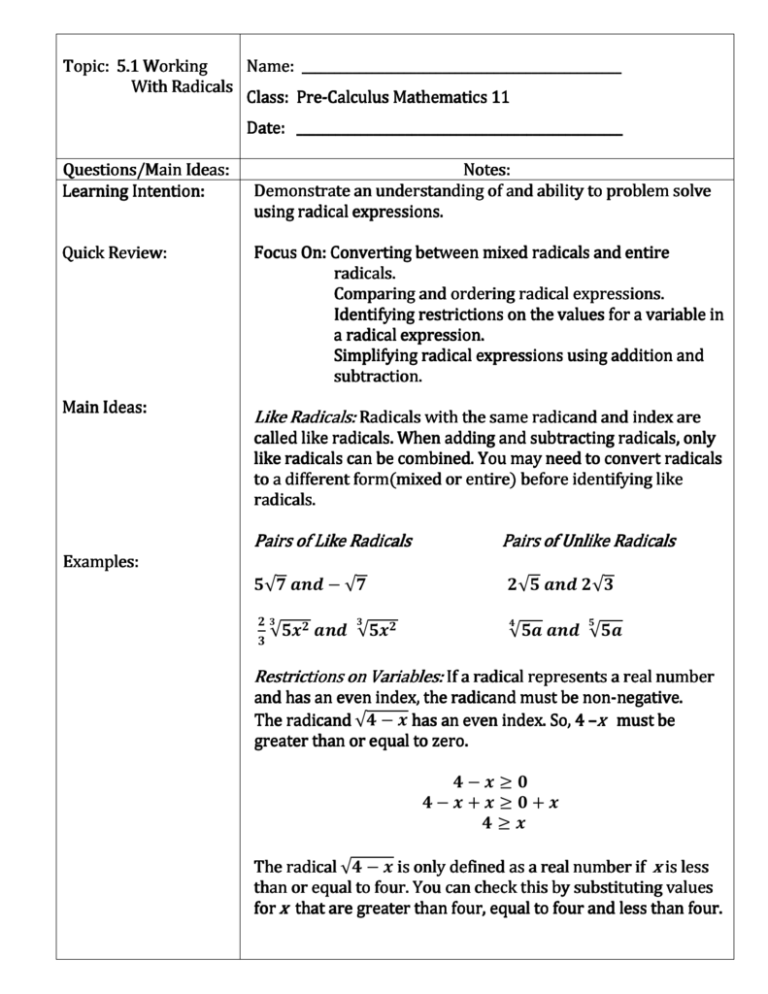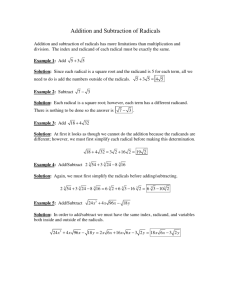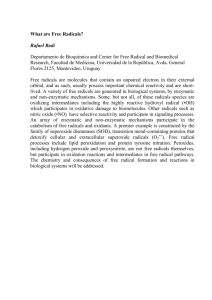Radical Expressions Worksheet: Pre-Calculus 11
advertisement

Topic: 5.1 Working Name: ____________________________________ __________________________________________________ _________________________________ With Radicals Class: PrePre-Calculus Mathematics 11 Date: ____________________________________ ___________________________________________________ _________________________________ Questions/Main Ideas: Learning Intention: Notes: Demonstrate an understanding of and ability to problem solve using radical expressions. expressions. Quick Review: Focus On: Converting between mixed radicals and entire radicals. Comparing and ordering radical expressions. Identifying restrictions on the values for a variable in a radical expression. Simplifying radical expressions using addition and and subtraction. Main Ideas Ideas: Like Radicals: Radicals with the same radicand and index are called like radicals. When adding and subtracting radicals, only like radicals can be combined. You may need to convert radicals to a different form(mixed or entire) before identifying like radicals. Examples: Pairs of Like Radicals 4√6 789 : √6 ;< < < √4=; 789 √4=; Pairs of Unlike Radicals ;√4 789 ;√< > 4 √47 789 √47 Restrictions on Variables: If a radical represents a real number and has an even index, the radicand must be nonnon-negative. The radicand √> : = has an even index. So, 4 –x must be greater than or equal to zero. >:=DE >:=F=DEF= >D= The radical √> : = is only defined as a real number if x is less than or equal to four. You can check this by substituting values for x that are greater than four, equal to four and less than four. Teaching Examples: Convert Mixed Radicals to Entire Radicals Express each mixed radical in entire radical form. Identify the values of the variable for which the radical represents a real number. a) 6√; b) 7> √7 < c) 4H√<H; Radicals in Simplest Form: A radical is in simplest form if the Hint: Make a list of all perfect squares when converting radicals to simplest form. following are true. • The radicand does not contain a fraction or any factor which may be removed. • The denominator does not contain a radical. For example, √JK is not in simplest form because 18 has a square factor of 9, which can be removed. √JK is equivalent to the simplified form<√;. form Teaching Examples: Express Entire Radicals as Mixed Radicals Convert each entire radical to a mixed radical in simplest form. a) √;EE > b) √NO c) P>KQ4 Compare and Order Radicals Five bentwood boxes, each in the shape of a cube have the following diagonal lengths, in centimeters. J >(J<); K√< J> √;E; JE√; Order the diagonal lengths from least to greatest without using a calculator. Add and Subtract Radicals Simplify radicals and combine like terms. a) √4E F <√; b) :√;6 F <√4 : √KE : ;√J; c) √>N : >√ON, N D E Something challenging Apply Addition of Radical Expressions Consider the design show for a Skateboard ramp. What is the Exact distance across the base? Next Step: #1#1-4, 5a, c, 6a, c, 8a, c, 9a, c, 10a, c, 15, 20 40cm 30° 30cm 30°






